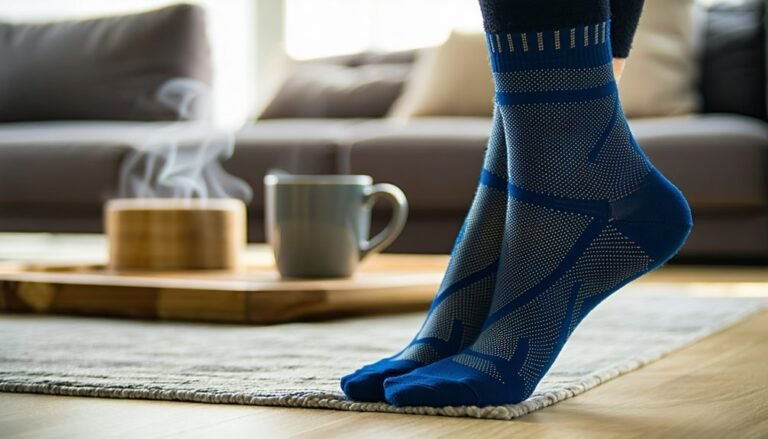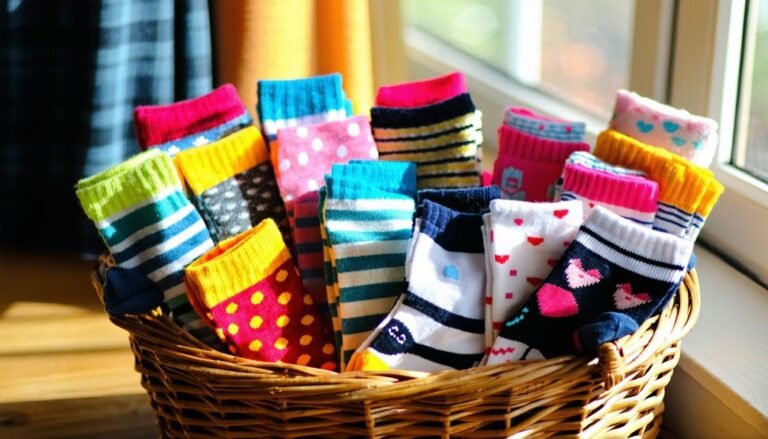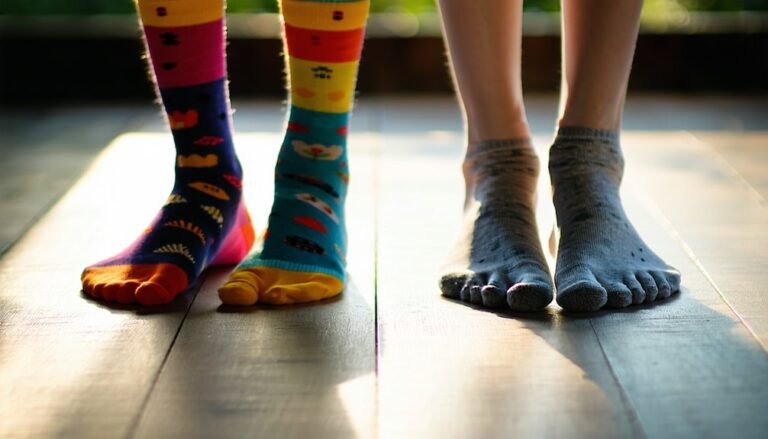Can Compression Socks Make Spider Veins Worse?
Compression socks don't exacerbate spider veins. Instead, they enhance venous circulation by applying graduated pressure to your legs. This reduces venous pressure and alleviates symptoms like heaviness or discomfort. Evidence shows compression therapy aids in managing chronic venous insufficiency without worsening vein visibility. Choosing the right compression level, typically 15-20 mmHg, is essential for effective relief. Consider learning about the benefits and proper selection to support your vein health effectively.
Understanding Spider Veins: Causes and Symptoms

Spider veins, medically known as telangiectasias, are small, dilated blood vessels visible near the surface of the skin, often appearing on the legs and face. Their development is multifactorial, involving genetic predisposition, hormonal influences, and prolonged standing or sitting. Symptoms may include a sensation of heaviness, aching, or itching in the affected area. While spider veins are generally benign, understanding treatment options is essential for effective management and prevention of complications.
Evidence-based treatment options include sclerotherapy, laser therapy, and radiofrequency ablation. Sclerotherapy involves injecting a sclerosant solution into the vein, causing it to collapse and fade. Laser therapy uses focused light to target and diminish veins. Radiofrequency ablation employs heat to close off problematic veins. These methods prioritize safety and effectiveness for best outcomes.
How Compression Socks Work: A Brief Overview
Although often overlooked, compression socks play a pivotal role in managing spider veins and improving venous health. These specialized garments apply graduated pressure to your lower extremities, aiding in circulation improvement by encouraging blood flow back to the heart. Compression sock types vary in pressure levels, typically measured in millimeters of mercury (mmHg), and are designed to meet specific medical needs. Light compression (15-20 mmHg) is often sufficient for mild symptoms, while moderate to firm compression (20-40 mmHg) is recommended for more pronounced venous issues. Evidence supports that consistent use of appropriate compression sock types can reduce the risk of vein complications. By enhancing venous return and reducing venous pressure, compression socks provide a proactive approach to managing spider veins safely.
The Role of Compression Socks in Blood Circulation
Understanding the mechanism of compression socks sets the stage for appreciating their impact on blood circulation. When you wear these specialized garments, they apply graduated pressure on your lower extremities, with the highest compression at the ankles, gradually decreasing upwards. This pressure gradient is essential for enhancing blood flow back to the heart, effectively counteracting venous stasis. By compressing the surface veins, arteries, and muscles, compression socks reduce vein pressure, aiding in the prevention of blood pooling. This, in turn, supports efficient circulation, minimizing potential complications such as swelling and discomfort. For those concerned about safety, rest assured that these socks are designed to optimize hemodynamics without compromising vascular health, thereby serving as a preventive measure against circulatory issues.
Potential Benefits of Compression Socks for Spider Veins

While compression socks are widely recognized for their role in enhancing circulation, their potential benefits for managing spider veins shouldn't be overlooked. Compression therapy promotes vein support by applying graded pressure to the legs, reducing venous pressure and improving blood flow. This can help alleviate discomfort and swelling associated with spider veins. By compressing the surface veins, these socks may also minimize visible vein appearance, offering an aesthetic advantage.
| Benefit | Mechanism | Emotional Impact |
|---|---|---|
| Venous Support | Improves blood flow | Sense of relief |
| Swelling Reduction | Decreases fluid retention | Comfort |
| Aesthetic Improvement | Minimizes visible veins | Enhanced confidence |
Using compression socks is a safe, non-invasive approach that can effectively contribute to spider vein management, providing physical and emotional reassurance.
Common Concerns About Compression Socks and Spider Veins
When considering the application of compression socks for spider veins, it's essential to understand both the physiological benefits and common misconceptions. Compression therapy can enhance venous return and reduce venous pressure, but some individuals mistakenly believe that wearing these socks might exacerbate their condition. Evidence supports that, when used correctly, compression socks are a safe adjunct in the management of venous disorders, addressing concerns about their efficacy and potential adverse effects.
Compression Benefits for Veins
Even though spider veins are often a cosmetic concern, compression socks provide significant medical benefits by improving venous return. When you wear them, these socks apply graduated pressure, which helps enhance blood circulation by exerting higher pressure at the ankle and gradually decreasing it up the leg. This specific pressure gradient, known as compression levels, supports the veins in efficiently pushing blood back to the heart.
Misconceptions About Sock Use
Many individuals harbor misconceptions about the use of compression socks, particularly in relation to spider veins. It's essential to have these misconceptions clarified and myths debunked to guarantee safe, effective use. One prevalent myth is that compression socks exacerbate spider veins, but evidence demonstrates they improve venous return, reducing venous pressure.
Consider these common misconceptions:
- Compression socks are uncomfortable: Advances in materials and design have enhanced comfort considerably.
- They're only for older adults: Individuals of all ages, especially those standing long hours, can benefit.
- Daily wear is unnecessary: Regular use can prevent worsening of venous conditions.
- Only medical professionals should recommend them: While professional guidance is beneficial, many types are available for general use.
Understanding these points guarantees you're making informed decisions about your vascular health.
Scientific Studies on Compression Socks and Vein Health
You may wonder how compression socks function to enhance venous health, and scientific studies have provided insights into their mechanism of action. These socks exert graduated pressure on the lower extremities, promoting venous return and reducing venous pressure. Clinical trials have consistently demonstrated improvements in symptoms related to chronic venous insufficiency, validating the efficacy of compression therapy for vein health.
Compression Socks Mechanism
Numerous scientific studies have elucidated the mechanism through which compression socks benefit vein health, particularly in the management of spider veins. By applying graduated pressure, these socks enhance venous return, reducing venous stasis and mitigating the risk of vein dilation. Ideal compression levels, typically ranging from 15-30 mmHg, are vital for efficacy. Sock materials, often a blend of nylon and spandex, guarantee elasticity and durability, providing consistent pressure over time.
- Graduated compression: Guarantees higher pressure at the ankle, decreasing upwards.
- Enhanced circulation: Promotes blood flow, reducing venous hypertension.
- Reduced leg swelling: Alleviates edema associated with venous insufficiency.
- Material technology: Advanced fibers maintain compression levels, enhancing safety.
When choosing compression socks, confirm they're medically graded and fitted correctly for maximum safety and effectiveness.
Vein Health Benefits
Building on the understanding of how compression socks function, scientific studies have confirmed their substantial benefits for vein health. Compression socks are designed to exert graduated pressure on your legs, which enhances blood flow and supports vein strengthening. This mechanical support reduces venous pressure, thus mitigating the progression of venous disorders. By facilitating efficient blood circulation, compression socks help to prevent the pooling of blood in the lower extremities, a primary factor in the formation of spider veins. Studies have shown that consistent use of these socks can lead to improved venous return and decreased swelling. Consequently, wearing compression socks offers a scientifically-backed method for enhancing the health of your veins, promoting circulatory efficiency, and ensuring vascular safety.
Clinical Study Outcomes
While examining the efficacy of compression socks, a multitude of clinical studies have provided compelling evidence supporting their role in vein health management. Clinical trial findings consistently highlight the sock effectiveness in reducing symptoms associated with venous insufficiency. By applying graduated pressure, these socks enhance venous return and reduce edema, essential for spider vein prevention.
Key outcomes from clinical studies include:
- Reduced Venous Pressure: Demonstrated decrease in venous pressure levels, aiding in symptom alleviation.
- Improved Blood Flow: Enhanced circulation and reduced vascular inflammation were frequently observed.
- Symptom Relief: Participants reported noticeable improvements in heaviness and discomfort.
- Prevention of Venous Complications: Evidence points towards effective prevention of complications like deep vein thrombosis.
Utilizing compression socks is a proactive approach to maintaining ideal vein health, ensuring your safety and well-being.
Comparing Compression Sock Types and Their Effects
When considering the types of compression socks available, it is important to understand their varying effects on spider veins. Compression levels are significant—ranging from mild (8-15 mmHg) to extra-firm (30-40 mmHg)—as they influence venous return and pressure distribution. Selecting the appropriate level mitigates exacerbation of spider veins. Sock materials also play an important role; breathable, hypoallergenic fabrics like nylon and spandex promote comfort and safety, reducing the risk of skin irritation. Technical design specifics, such as graduated compression, enhance circulation by applying more pressure at the ankle, tapering off upward. It's crucial to match sock types with individual venous conditions, promoting therapeutic efficacy and minimizing adverse outcomes. Consider evidence-based choices to optimize vascular health and prevent complications.
Expert Opinions on Compression Socks for Spider Veins

Understanding the types and effects of compression socks sets the stage for appreciating what experts say about their efficacy for spider veins. Medical professionals affirm that compression therapy can improve venous circulation, potentially alleviating symptoms associated with spider veins. Here's what you should know based on expert recommendations and patient experiences:
Compression therapy enhances venous circulation, offering potential relief for symptoms of spider veins.
- Clinical Studies: Research indicates that graduated compression socks enhance venous return, reducing pressure in superficial veins.
- Patient Feedback: Individuals often report symptomatic relief, including reduced leg swelling and discomfort.
- Expert Consensus: Vascular specialists advocate for the use of compression socks as a non-invasive management strategy.
- Safety Profile: Compression socks are generally safe, but you should consult a healthcare provider to guarantee proper fit and pressure level.
Adhering to these insights can guide effective management of spider veins.
Tips for Choosing the Right Compression Socks
Selecting the appropriate compression socks is crucial for effective spider vein management, as the right choice can enhance therapeutic benefits and comfort. Begin by evaluating your required compression levels, typically measured in millimeters of mercury (mmHg). For spider veins, a mild to moderate range (15-20 mmHg) is often recommended, but consult a healthcare professional for personalized advice.
Consider fabric materials that promote breathability and moisture-wicking, such as nylon or spandex blends, to prevent skin irritation. Guarantee the socks provide a snug fit without excessive tightness to avoid compromising circulation. Look for graduated compression, where pressure decreases from ankle to calf, to optimize venous return. Prioritize certified medical-grade products for verified efficacy and durability. Your choices can markedly influence the therapeutic outcomes.
Lifestyle Changes to Support Vein Health
While choosing the right compression socks is a significant step in managing spider veins, incorporating lifestyle changes can further enhance vein health. Effective measures include dietary changes to reduce sodium intake, supporting ideal circulation. Consistent exercise routines improve venous return, while hydration habits maintain blood viscosity. Prioritizing weight management relieves undue pressure on leg veins. Elevating your legs, practicing stress reduction techniques, and improving posture can mitigate vascular stress. Thoughtful footwear selection aids in proper alignment, and smoking cessation is essential for vascular health. Regular daily movement prevents blood pooling, decreasing spider vein progression. To effectively support your vein health, consider these strategies:
- Exercise routines: Enhance venous return.
- Hydration habits: Maintain blood viscosity.
- Leg elevation: Relieve pressure on veins.
- Stress reduction: Mitigate vascular stress.
Frequently Asked Questions
Can Compression Socks Be Worn Overnight?
You'd think wearing compression socks overnight would turn you into a superhero by morning, right? While the compression sock benefits are real, evidence suggests overnight usage isn't unsafe but may cause discomfort for some. Consult your healthcare provider.
Are There Any Side Effects of Wearing Compression Socks?
When considering compression socks, you're wondering about side effects. Typically mild, they might include skin irritation or discomfort. Always consult medical advice for personalized guidance, ensuring safe use tailored to your vascular health needs and individual circumstances.
Do Compression Socks Work for All Age Groups?
Compression socks' effectiveness varies by age, offering distinct age-related benefits. Younger individuals might experience improved athletic performance, while older adults often notice enhanced venous return and reduced edema. Always consult healthcare professionals for personalized recommendations and safety.
How Long Should I Wear Compression Socks Daily?
Oh, you'd love to wear compression socks 24/7, wouldn't you? But alas, evidence-based guidelines suggest 8-10 hours daily usage. Adhering to this compression sock duration guarantees ideal circulation without compromising safety or comfort.
Can I Wear Compression Socks During Exercise?
Wearing compression socks during exercise can enhance exercise benefits by improving circulation. They support venous return, reducing fatigue and swelling. Confirm proper fit and material, as evidence suggests they're beneficial when used correctly, promoting safety and performance.







